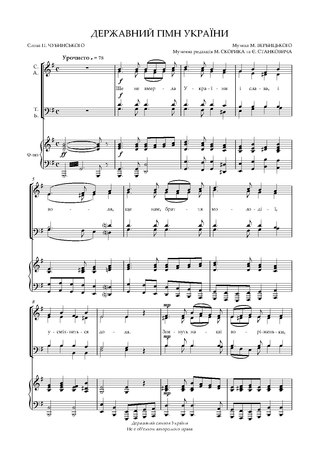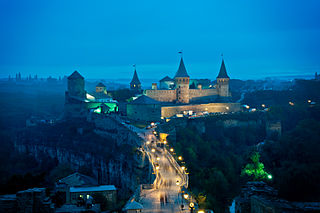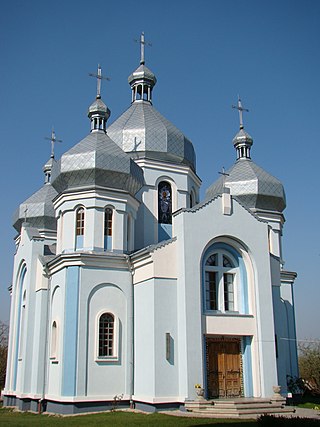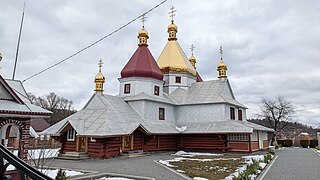
Latynnyky (Ukrainian : Латинники; Polish : Łacinnicy) [lower-alpha 1] was a term used by the Ukrainian population of Western Ukraine to refer to culturally-Ukrainian Roman Catholics during the Second Polish Republic.

Latynnyky (Ukrainian : Латинники; Polish : Łacinnicy) [lower-alpha 1] was a term used by the Ukrainian population of Western Ukraine to refer to culturally-Ukrainian Roman Catholics during the Second Polish Republic.
The phenomenon of Latynnyky emerged in the late 19th century, both in the Austro-Hungarian Kingdom of Galicia and Lodomeria and in Ukrainian areas of the Russian Empire. In Galicia and Lodomeria, Latynnyky emerged both among ethnic Ukrainians who had converted to the Latin Church and Polish people who had been assimilated into Ukrainian culture but retained their religion. [2]
In the Russian Empire, conversely, the growth of Latynnyky was a form of resistance to Russian efforts to spread Eastern Orthodoxy to members of the Ukrainian Greek Catholic Church in Chełm Land and Podlachia. Another wave of Catholicisation occurred in 1905, following a loosening of religious restrictions by the Russian government. Furthermore, in both Austria-Hungary and Russia, religious conversion to Catholicism was regarded by the local population as a requirement for marriages between Poles and Ukrainians. [1]
With the establishment of the Second Polish Republic following World War I, Latynnyky found themselves in Polish territory. At this time, according to Ukrainian nationalist historian Volodymyr Kubijovyč, Latynnyky had a weak national identity, and many later associated themselves with Poland, rather than Ukraine. [3]
After the Polish–Soviet border agreement of August 1945 formally annexed western Ukraine into the Soviet Union, most Latynnyky remained in the Ukrainian Soviet Socialist Republic and were fully assimilated into Ukrainian society. Others emigrated further westwards into Poland. [2]
The population of Latynnyky was placed at several numbers in a wide range depending on the demographer. Between 1869 and 1870, Ukrainian ethnographer Pavlo Chubynskyi recorded 32,041 Roman Catholics who natively spoke the Ukrainian language in the Lublin and Siedlce Governorates of Congress Poland. [4] The Russian Empire census in 1897 reported a number of 1,490,546 Roman Catholics who stated their native language as "Russian" (including Ukrainian, Belarusian, and Russian). [5]
After World War I, the 1921 Polish census recorded 16,239 ethnically-Ukrainian Roman Catholics. [6] According to Kubijovyč, however, this was a vast undershoot of the real population, which he claimed numbered at 360,000 between Podlachia, Chełm Land, and Lublin Voivodeship. [3] The General Government, Nazi Germany's occupational government over Poland, estimated that between 188,000 and 200,000 Latynnyky lived under their rule. [7] The Encyclopedia of Ukraine estimated a number of 700,000 in 1939, with 515,000 in Galicia and the remainder in Volhynia and Podolia. [2]

The State Anthem of Ukraine, also known by its incipit "Šče ne vmerla Ukrainy i slava, i volia" and its original title "Šče ne vmerla Ukraina", is one of the state symbols of Ukraine.

Podolia or Podillia is a historic region in Eastern Europe, located in the west-central and south-western parts of Ukraine and in northeastern Moldova.

Chełm is a city in southeastern Poland with 60,231 inhabitants as of December 2021. It is located to the south-east of Lublin, north of Zamość and south of Biała Podlaska, some 25 kilometres from the border with Ukraine. Chełm used to be the capital of the Chełm Voivodeship until it became part of the Lublin Voivodeship in 1999.

Galicia is a historical and geographic region spanning what is now southeastern Poland and western Ukraine, long part of the Polish–Lithuanian Commonwealth. It covers much of the other historic regions of Red Ruthenia and Lesser Poland.

Volhynia or Volynia is a historic region in Central and Eastern Europe, between southeastern Poland, southwestern Belarus, and northwestern Ukraine. The borders of the region are not clearly defined, but in Ukraine it is roughly equivalent to Volyn and Rivne Oblasts; the territory that still carries the name is Volyn Oblast.

Podlachia, also known by its Polish name Podlasie, is a historical region in north-eastern Poland. Its largest city is Białystok, whereas the historical capital is Drohiczyn.

Ternopil Oblast, also referred to as Ternopilshchyna or Ternopillia, is an oblast (province) of Ukraine. Its administrative center is Ternopil, through which flows the Seret, a tributary of the Dniester. Population: 1,021,713.

Volodymyr, previously known as Volodymyr-Volynskyi (Володимир-Волинський) from 1944 to 2021, is a small city in Volyn Oblast, northwestern Ukraine. It serves as the administrative centre of Volodymyr Raion and the center of Volodymyr urban hromada. It is one of the oldest cities in Ukraine and the historic centre of the region of Volhynia; it served as the capital of the Principality of Volhynia and later as one of the capital cities of the Kingdom of Galicia–Volhynia. Population: 37,910.

Western Ukraine or West Ukraine refers to the western territories of Ukraine. There is no universally accepted definition of the territory's boundaries, but the contemporary Ukrainian administrative regions (oblasts) of Chernivtsi, Ivano-Frankivsk, Lviv, Ternopil and Zakarpattia are typically included. In addition, Volyn and Rivne oblasts are also usually included. In modern sources, Khmelnytskyi Oblast is often included because of its geographical, linguistic and cultural association with Western Ukraine, although this can not be confirmed from a historical and political point of view. It includes several historical regions such as Carpathian Ruthenia, Halychyna including Pokuttia, most of Volhynia, northern Bukovina and the Hertsa region, and Podolia. Western Ukraine is sometimes considered to include areas of eastern Volhynia, Podolia, and the small northern portion of Bessarabia.

Volodymyr Kubijovyč was an anthropological geographer in prewar Poland, a wartime Ukrainian nationalist politician, a Nazi collaborator and a post-war émigré intellectual of mixed Ukrainian-Polish background.

Kozova is a rural settlement in Ternopil Raion, Ternopil Oblast, western Ukraine. It is located in the historical region of Galicia, 16 km (10 mi) east of Berezhany, some 30 km (19 mi) west of Ternopil, and 100 km (62 mi) southeast of Lviv. It hosts the administration of Kozova settlement hromada, one of the hromadas of Ukraine. The settlement is situated beside a lake on the Koropets River. There is presumption that the name Kozova comes from the Ukrainian word koza (goat), though other possible sources exist. Population: 8,750.

Pechenizhyn is a Rural settlement in Kolomyia Raion, Ivano-Frankivsk Oblast, Ukraine, 11 kilometres (7 mi) west of Kolomyia. It hosts the administration of Pechenizhyn settlement hromada, one of the hromadas of Ukraine. Its population is 5,197.

The Conversion of Chełm Eparchy was the forced conversion of the Eparchy of Chełm–Belz that took place between January and May 1875. It was the last eparchy of the Ruthenian Uniate Church that remained on the territory of the Russian Empire following the partitions of Poland. The episcopal seat of the eparchy was in the city of Chełm (Kholm) in Congress Poland. Adherents and clergy were forced to join the Russian Orthodox Church.
With the arrival of the Hungarians into the heart of the Central European Plain around 899, Slavic tribes of Vistulans, White Croats, and Lendians found themselves under Hungarian rule. In 955 those areas north of the Carpathian Mountains constituted an autonomous part of the Duchy of Bohemia and remained so until around 972, when the first Polish territorial claims began to emerge. This area was mentioned in 981, when Vladimir the Great of Kievan Rus' claimed the area on his westward way. In the 11th century the area belonged to Poland, then reverted to Kievan Rus'. However, at the end of the 12th century the Hungarian claims to the principality turned up. Finally Casimir III of Poland annexed it in 1340–1349. Low Germans from Prussia and Middle Germany settled parts of northern and western Galicia from the 13th to 18th centuries, although the vast majority of the historic province remained independent from German and Austrian rule.

Beresteishchyna is a region in Western Polesie, in what is primarily the modern Brest Region of Belarus. Located along the western Bug.

Duba is a village in Ivano-Frankivsk Oblast, Ukraine, located in Kalush Raion. It is the centre of the Duba rural hromada.

Vytvytsia is a village in Ivano-Frankivsk Oblast, Ukraine, in Kalush Raion. It is the administrative centre of Vytvytsia rural hromada. Its population is 1,255.

Novytsia is a village in Ivano-Frankivsk Oblast, Ukraine, in Kalush Raion. It is the administrative centre of Novytsia rural hromada. Its population is 3,733.

Piadyky is a village in Kolomyia Raion, Ivano-Frankivsk Oblast, Ukraine. It is the administrative centre of Piadyky rural hromada. Its population is 3,567.

Murovane, formerly Liashky Murovani is a village in Ukraine, in Lviv Raion within Lviv Oblast. It is part of Murovane rural hromada, and it has a population of 4,630.
{{cite book}}: CS1 maint: location missing publisher (link)